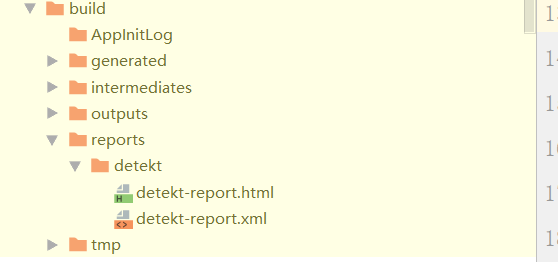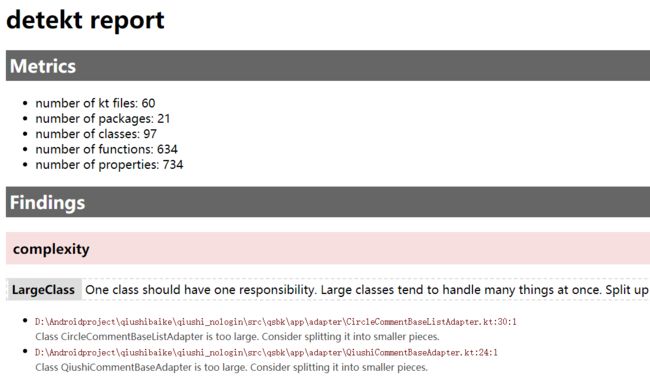关于kotlin
kotlin作为一个JVM语言,它在高度兼容Java代码的前提之下,对Java语言进行了极大的简化和升级,在保留了面向对象的编程语言的优势前提下,拔高语言中函数的地位并拓展函数的能力,为开发者提供了函数式的编程框架,各种函数用法使kotlin代码极其简洁,甚至乍一看已经和Java完全不同了,,以上种种保证它可以不影响现有代码的前提下,提高后续的代码开发效率。因此kotlin这几年在迅速普及,据我所知,大量的前后端开发团队都已经在使用kotlin了。
既然kotlin大家都在用,那么我们如何写好kotlin代码呢?最佳选择当然是参考官方教程或者官方代码规范指导等等文档来写。比如作为Android开发的推荐编程语言,Android官方提出了一些代码规范:Kotlin代码风格指导,而kotlin自己的官方语言教程里面其实也有各种各样的代码规范。
也就是说,想要自己写出更规范和健壮(稳定)的kotlin代码,就需要熟悉所有相关的规则规范和kotlin一些语言教程的文档
这好像是一句正确的废话...
当然,熟读完并且记住所有的规则规范然后写代码的时候不出错,显然有些强人所难了,因此,我们需要一个插件来记住所有的代码规则规范,然后扫描我们的代码,然后帮助我们分析自己的kotlin代码。
kotlin编码规范最全的还是 ktlint,ktlint项目不仅参考了Android官方的Kotlin style guide,而且还有kotlin官方的编码规范等等。因此ktlint是一个不错的选择。
但是,一段好的代码不仅仅是代码格式的规范,代码本身应该具备稳定性,即代码运行没有性能或崩溃隐患,所以代码分析插件最好能指出哪些代码片段会影响代码稳定性,而ktlint主要能力还是检查编码规范,无法扫描kotlin代码中的性能问题和隐患代码,因此不算完美。
好了,不卖关子了,介绍下detekt。目前来讲,它相对更全面的Kotlin代码分析插件。
detekt是一款kotlin静态代码分析工具,它可以检查kotlin的编码规范,也能检查代码的性能开销和隐患,而且,你可以自定义自己的代码分析规则体系,这样,你就不必全盘接受代码所有代码规范,可以去掉那些无关紧要的规则检查,让开发相对灵活一些。
detekt使用简介
安装
参考官网,其实安装使用的方式有很多种,这里介绍一种。
- 单独gradle文件集成
以下配置写在一个单独的gradle文件中
repositories {
// if you 'gradle install' all detekt modules
mavenLocal()
// or when all modules should be provided
maven {
url "http://dl.bintray.com/arturbosch/code-analysis"
}
}
configurations {
detekt
}
task detekt(type: JavaExec) {
main = "io.gitlab.arturbosch.detekt.cli.Main"
classpath = configurations.detekt
def input = "$project.projectDir.absolutePath"
// detekt.yml就是我们可自定义的代码分析规则的配置文档,后面会讲
def config = "$project.projectDir/detekt.yml"
def filters = ".*test.*"
...
...
// 输出结果的文件,可选html,xml,或txt等其他格式
def output = "$project.projectDir/reports/detekt/detekt-report.html"
def outputXml = "$project.projectDir/reports/detekt/detekt-report.xml"
def params = [ '-p', input, '-c', config, '-f', filters, '-r', "html:$output",'-r', "xml:$outputXml"]
args(params)
}
dependencies {
detekt 'io.gitlab.arturbosch.detekt:detekt-cli:1.0.0.[CURRENT_MILESTONE]'
detekt 'io.gitlab.arturbosch.detekt:detekt-formatting:1.0.0.[CURRENT_MILESTONE]'
}
然后命令行运行gradle detekt即可,默认输出文件在build文件夹下,当然我们也可以自己配置输出目录地址。
代码分析规则
上面提到的输入文件detekt.yml就是detekt分析kotlin代码的分析规则依据,我们可以自定义编写规则,detekt可以定义的规则类型分为9类
- comments 注释文档规范检查
- complexity 复杂度检查
- empty-blocks 空block检查
- exceptions 表达式规范检查
- formatting 格式规范检查
- naming 命名规范检查
- performance 性能检查
- potential-bugs 潜在bug检查
- style 代码风格检查
举个例子,以下是糗百项目中使用的部分规则配置(其实主要是根据默认配置文件来选择自己需要的规则配置)
test-pattern: # Configure exclusions for test sources
active: true
patterns: # Test file regexes
- '.*/test/.*'
- '.*/androidTest/.*'
- '.*Test.kt'
- '.*Spec.kt'
- '.*Spek.kt'
exclude-rule-sets:
- 'comments'
exclude-rules:
- 'NamingRules'
- 'WildcardImport'
- 'MagicNumber'
- 'MaxLineLength'
- 'LateinitUsage'
build:
maxIssues: 1 # 发现超过多少个问题时,task返回结果失败
weights: #比重
# complexity: 2
# LongParameterList: 1
# style: 1
# comments: 1
comments:
active: false // 是否激活该规则
CommentOverPrivateFunction:
active: false
CommentOverPrivateProperty:
active: false
EndOfSentenceFormat:
active: false
endOfSentenceFormat: ([.?!][ \t\n\r\f<])|([.?!]$)
UndocumentedPublicClass:
active: false
searchInNestedClass: true
searchInInnerClass: true
searchInInnerObject: true
searchInInnerInterface: true
UndocumentedPublicFunction:
active: false
complexity:
active: true
ComplexCondition: #条件是否过于复杂
active: true
threshold: 4 临界值
ComplexInterface:
active: false
threshold: 10
includeStaticDeclarations: false
ComplexMethod: #方法复杂难懂
active: false
threshold: 10
ignoreSingleWhenExpression: false
ignoreSimpleWhenEntries: false
NestedBlockDepth: # 嵌套深度检查
active: true
threshold: 4 #阈值
StringLiteralDuplication:
active: false
threshold: 3
ignoreAnnotation: true
excludeStringsWithLessThan5Characters: true
ignoreStringsRegex: '$^'
TooManyFunctions: # 单个文件/对象内部的方法数限定,功能单一原则
active: false
thresholdInFiles: 11
thresholdInClasses: 11
thresholdInInterfaces: 11
thresholdInObjects: 11
thresholdInEnums: 11
ignoreDeprecated: false
ignorePrivate: false
ignoreOverridden: false
empty-blocks:
active: true
EmptyCatchBlock:
active: true
allowedExceptionNameRegex: "^(_|(ignore|expected).*)"
EmptyClassBlock: # 空的class,不需要{}
active: true
exceptions:
active: true
ExceptionRaisedInUnexpectedLocation:
active: false
methodNames: 'toString,hashCode,equals,finalize'
ThrowingNewInstanceOfSameException:
active: false
TooGenericExceptionCaught: #异常捕获范围太广
active: false
exceptionNames:
- ArrayIndexOutOfBoundsException
- Error
- Exception
- IllegalMonitorStateException
- NullPointerException
- IndexOutOfBoundsException
- RuntimeException
- Throwable
allowedExceptionNameRegex: "^(_|(ignore|expected).*)"
formatting:
active: true
android: false
autoCorrect: true
MaximumLineLength: # 单行最长的长度,暂时不启用检查
active: false
maxLineLength: 120
ModifierOrdering: # 修饰符一致性
active: true
autoCorrect: true
NoBlankLineBeforeRbrace:
active: false
autoCorrect: true
NoConsecutiveBlankLines: # 没有连续的空行
active: true
autoCorrect: true
NoWildcardImports: # 没有通配符的倒导入
active: true
autoCorrect: true
# PackageName:
# active: true
# autoCorrect: true
ParameterListWrapping:
active: true
autoCorrect: true
indentSize: 4
naming:
active: true
ClassNaming: # class name 首字母大写
active: true
classPattern: '[A-Z$][a-zA-Z0-9$]*'
FunctionMinLength:
active: false
minimumFunctionNameLength: 3
FunctionNaming: #fun命名规则
active: true
functionPattern: '^([a-z$][a-zA-Z$0-9]*)|(`.*`)$'
excludeClassPattern: '$^'
ignoreOverridden: true
FunctionParameterNaming: #fun param 命名规则 驼峰
active: true
parameterPattern: '[a-z][A-Za-z0-9]*'
excludeClassPattern: '$^'
ignoreOverriddenFunctions: true
MatchingDeclarationName: # kt文件中,只有一个类的情况下,最好保持类名文件名一致,一个文件多个类的情况下,选择能描述这些类的文件名称
active: true
MemberNameEqualsClassName: # 成员名和类名混淆,暂时不起用
active: false
ignoreOverriddenFunction: true
ObjectPropertyNaming: # 对象属性命名规则
active: true
constantPattern: '[A-Za-z][_A-Za-z0-9]*'
propertyPattern: '[A-Za-z][_A-Za-z0-9]*'
privatePropertyPattern: '(_)?[A-Za-z][_A-Za-z0-9]*'
VariableNaming:
active: true
variablePattern: '[a-z][A-Za-z0-9]*'
privateVariablePattern: '(_)?[a-z][A-Za-z0-9]*'
excludeClassPattern: '$^'
ignoreOverridden: true
performance:
active: true
ArrayPrimitive: # 数组类型避免开装箱开销
active: true
ForEachOnRange: # ForEach循环代码的检查
active: true
SpreadOperator:
active: false
UnnecessaryTemporaryInstantiation: #类型转化的性能检查
active: true
potential-bugs:
active: true
ExplicitGarbageCollectionCall: # 垃圾回收的代码检查
active: true
InvalidRange: #非法的range
active: false
IteratorHasNextCallsNextMethod: #迭代器代码检查
active: true
IteratorNotThrowingNoSuchElementException: # 迭代器实现规范
active: false
MissingWhenCase: #when的case条件不全
active: true
LateinitUsage:
active: true
excludeAnnotatedProperties: ""
ignoreOnClassesPattern: ""
UnsafeCallOnNullableType: # 不安全的空指针判断
active: true
UnsafeCast: #不安全的类型转换
active: true
UselessPostfixExpression: # 无用的后缀表达式
active: true
以上这些定制规则,只是截取的一部分,大家使用detekt时,可以根据自己的需要来选择。
规则文档
输出结果
当你在命令行运行gradlew detekt之后,代码检查的结果会出现在你之前配置的路径下,比如build目录下:
输出的代码检查报告有不同的格式:xml,html,txt等,本质上是对代码检查结果的不同组织形式。
一下时html格式在浏览器中打开的样子如下:
这样,你就很方便的看到项目中所有kotlin代码的问题了,根据它的提示一一改正之后,重新运行代码分析插件直到不再有错误即可。


